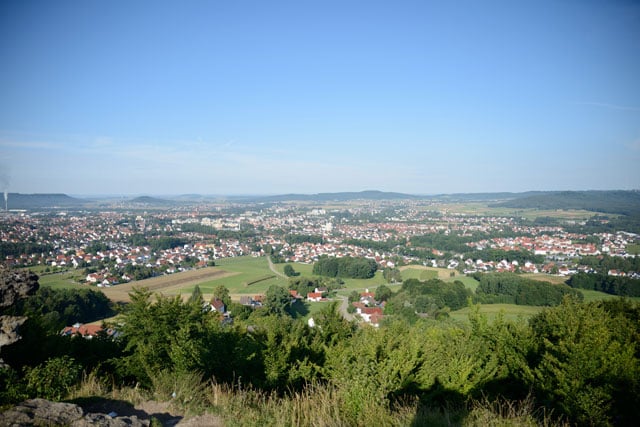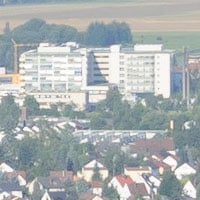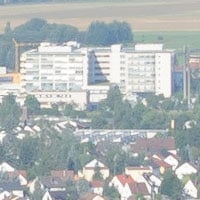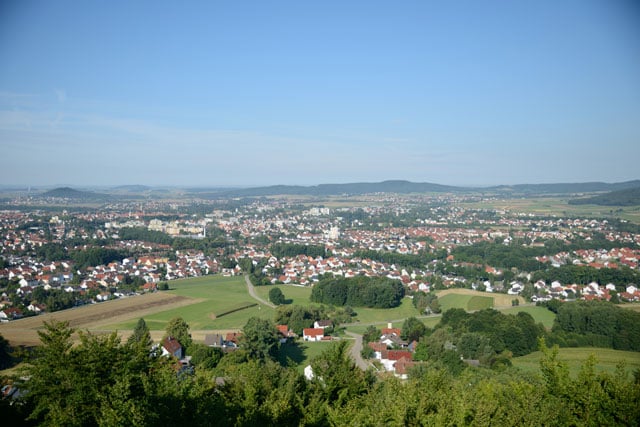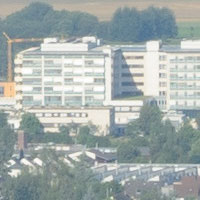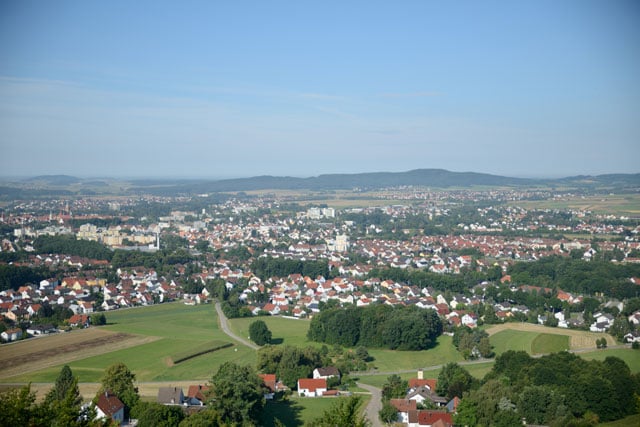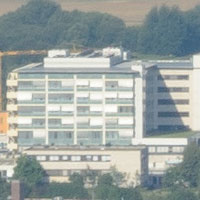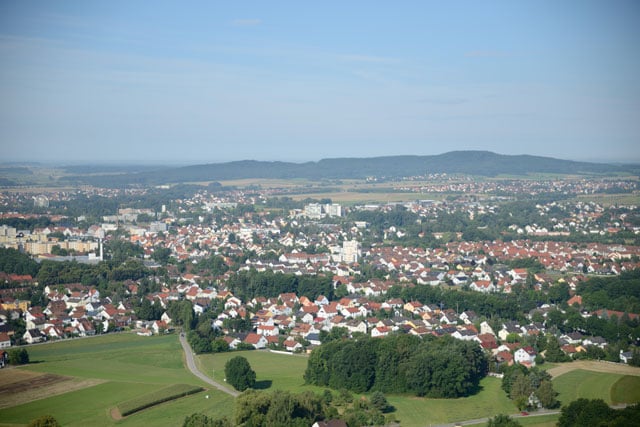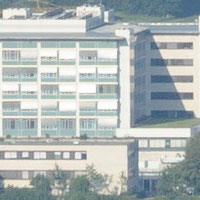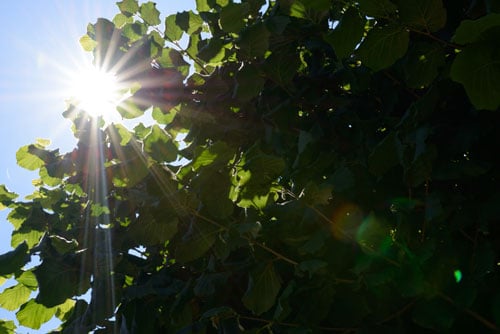Tamron 24-70mm f2.8 VC review
-
-
Written by Thomas
Quality
Testing: Longitudinal Chromatic Aberration
With lenses offering an aperture of f2.8 or larger I test for longitudinal CA (loCA, a.k.a. “axial color” or “bokeh CA”). The Tamron 24-70mm f2.8 VC shows very little loCA. The left side shows almost no magenta coloration and on the right the greenish hue is also very subtle. The alternating colorations of the vertical marks are a sign of color-moire only and have nothing to do with loCAs.
Tamron 24-70mm f/2.8 VC Longitudinal Chromatic Aberration (loCA) |
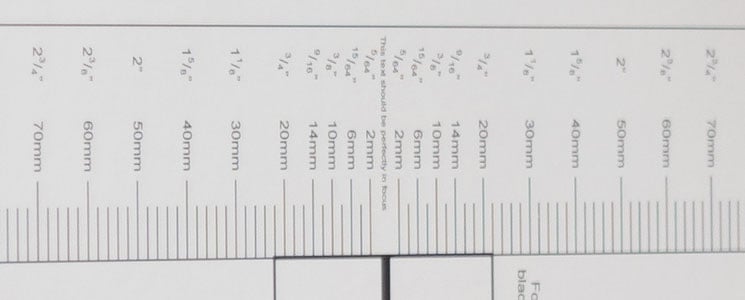 |
| 100% crop, 70mm, f2.8, left=closer, right=farther away |
Sharpness and contrast
Let’s have a look at the theoretical performance (MTF-charts) at the wide and the long end first:
Tamron 24-70mm f/2.8 VC MTF | ||
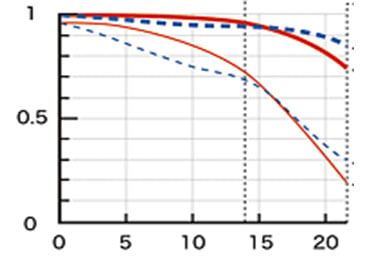 | ||
| at 24mm, f2.8 | at 70mm, f2.8 | |
These charts show the lens-performance at the largest aperture f2.8. Higher values are better and the closer the dotted and the continuous lines of each color are together the less astigmatism (= resolution depends on the orientation of the test-pattern) the lens has. The x-axis displays the distance from the optical axis (=center of the sensor) in mm. I’ll show you the real-life performance at 4 mm (center), 13 mm (APS-C/DX-corner), and 20 mm (full-frame/FX-corner) on a D800.
From the charts the new lens should perform on a pretty high level, especially in the DX image-circle (dotted line at 14mm). Contrast should be very high too and astigmatism looks like it should be nothing to worry about. So on paper Tamron’s latest design looks like a winner. Let’s see how this theoretical performance translates into real life results in the sharpness test based on Siemens-stars.
What follows are near-center results (first column) followed by DX-corner results and FX-corner results on a D800. The D800 results from the DX-corner should be a very good approximation for performance on a 16MP DX sensor (like the D7000), because the pixel-pitch of both sensors are the same. But differences in the AA-filter and micro-lens-design of a D800 and a D7000 might yield different end-results.
Processing was done in Lightroom 4.1 from RAW at camera standard settings. Noise-reduction is set to 0, sharpening to 70/0.5/36/10, with no extra tone, color, or saturation-adjustment. White-balance was adjusted to a neutral white and I did some exposure compensation to make the brightness match. CA-removal is ON.
All shots in the following section plus the landscape-shots were all done with a second copy of this lens. The first copy was decentered and showed a weak performance on the left side so I got a new copy for testing from Tamron Germany. Unfortunately that second copy did not stop down much between f2.8 and f4.0. So f4.0 was effectively only f3.2 and I had to stop down another 2/3 of a stop for each test-shot to compensate for this defect.
The following are all 100% crops!
Let’s have a look at the performance at 24mm first:
Tamron 24-70mm f/2.8 VC with Nikon D800 100% crop from center | Tamron 24-70mm f/2.8 VC with Nikon D800 100% crop from DX-corner | Tamron 24-70mm f/2.8 VC with Nikon D800 100% crop from FX-corner | ||
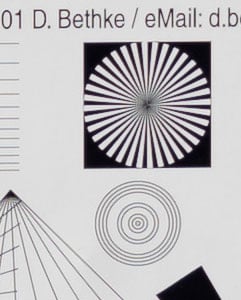 | 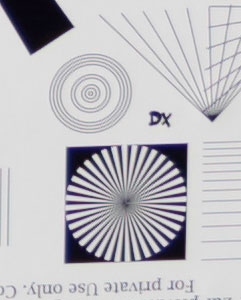 | 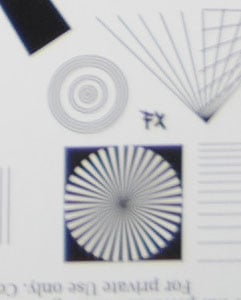 | ||
24mm, f2.8, 100 ISO | 24mm, f2.8, 100 ISO | 24mm, f2.8, 100 ISO | ||
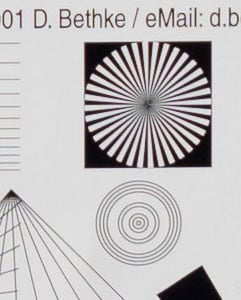 | 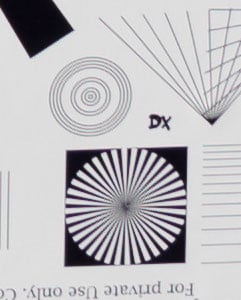 | 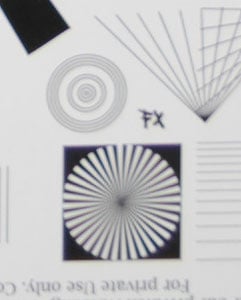 | ||
24mm, f4.0, 100 ISO | 24mm, f4.0, 100 ISO | 24mm, f4.0, 100 ISO | ||
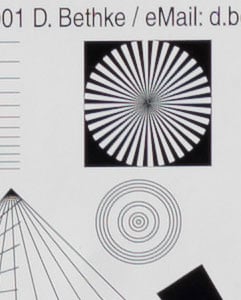 | 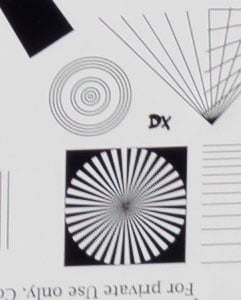 | 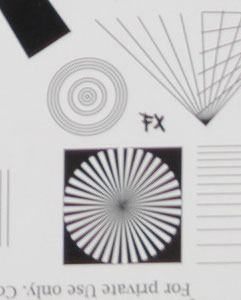 | ||
24mm, f5.6, 100 ISO | 24mm, f5.6, 100 ISO | 24mm, f5.6, 100 ISO | ||
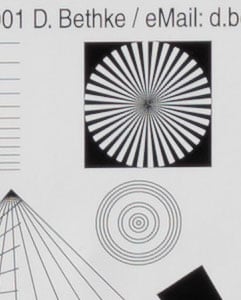 | 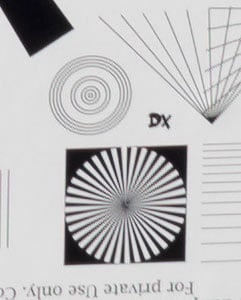 | 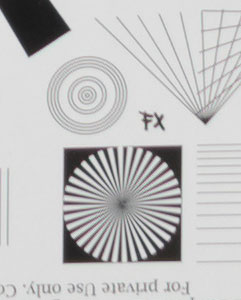 | ||
24mm, f8.0, 100 ISO | 24mm, f8.0, 100 ISO | 24mm, f8.0, 100 ISO | ||
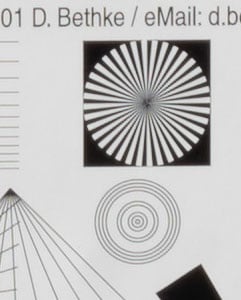 | 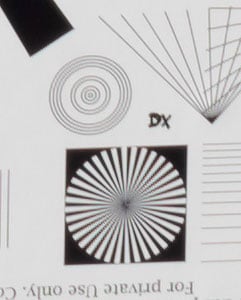 | 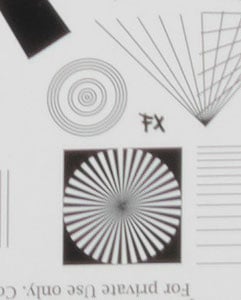 | ||
24mm, f11, 100 ISO | 24mm, f11, 100 ISO | 24mm, f11, 100 ISO |
These 100% crops directly from a 36MP D800 sensor show that this lens performs excellent in the center with diffraction setting in at f11. The performance in the DX-corner is also very good even wide open but suffers visibly from distortions. Towards the FX-corner there’s a clear drop in performance with some astigmatism and haloing. Even stopping down to f8 brings the FX-corner only up to good levels. Interestingly distortions are lower in the FX-corner than at the DX-corner.
Performance at 35mm:
Tamron 24-70mm f/2.8 VC with Nikon D800 100% crop from center | Tamron 24-70mm f/2.8 VC with Nikon D800 100% crop from DX-corner | Tamron 24-70mm f/2.8 VC with Nikon D800 100% crop from FX-corner | ||
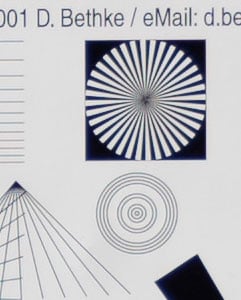 | 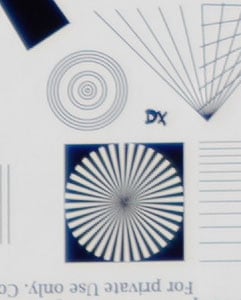 | 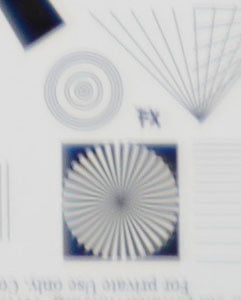 | ||
35mm, f2.8, 100 ISO | 35mm, f2.8, 100 ISO | 35mm, f2.8, 100 ISO | ||
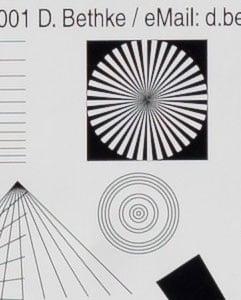 | 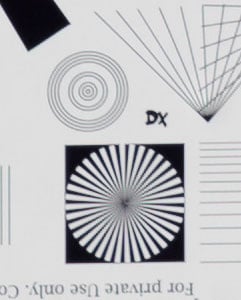 | 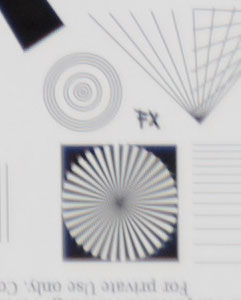 | ||
35mm, f4.0, 100 ISO | 35mm, f4.0, 100 ISO | 35mm, f4.0, 100 ISO | ||
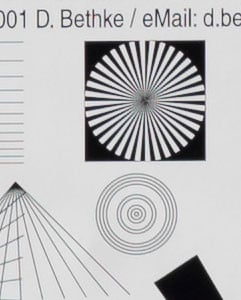 | 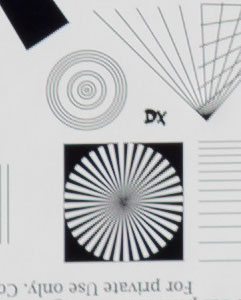 | 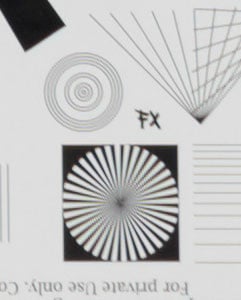 | ||
35mm, f5.6, 100 ISO | 35mm, f5.6, 100 ISO | 35mm, f5.6, 100 ISO | ||
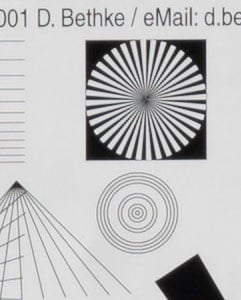 | 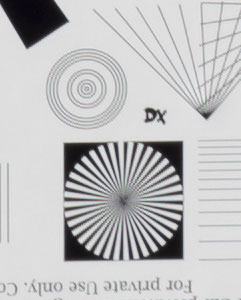 | 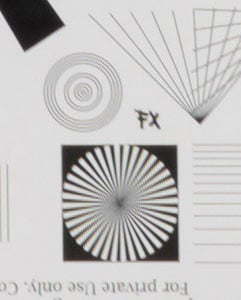 | ||
35mm, f8.0, 100 ISO | 35mm, f8.0, 100 ISO | 35mm, f8.0, 100 ISO | ||
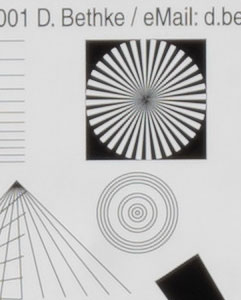 | 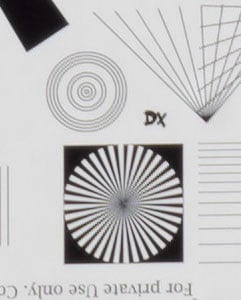 | 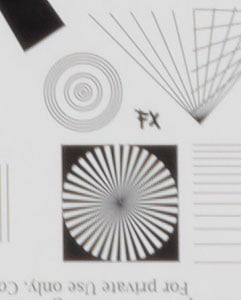 | ||
35mm, f11, 100 ISO | 35mm, f11, 100 ISO | 35mm, f11, 100 ISO |
Center performance continues to excel. And remember: the star-targets and the concentric circles on the left are already 4-5 mm off center, defining a broader sweet-spot of 8-10 mm diameter than a simply dead-center target could measure. The DX-corner is a bit soft wide open and profits from stopping down to f5.6 or f8. The FX-corner is disappointing wide open with prominent astigmatism even at f8.
Let’s move on to 50mm:
Tamron 24-70mm f/2.8 VC with Nikon D800 100% crop from center | Tamron 24-70mm f/2.8 VC with Nikon D800 100% crop from DX-corner | Tamron 24-70mm f/2.8 VC with Nikon D800 100% crop from FX-corner | ||
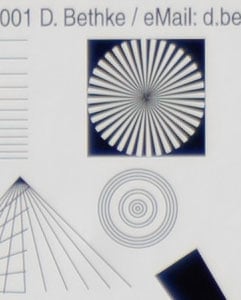 | 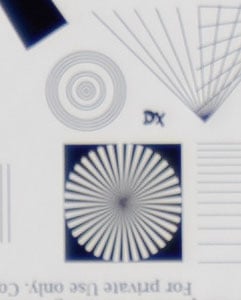 | 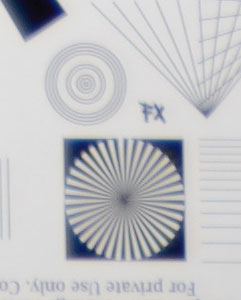 | ||
50mm, f2.8, 100 ISO | 50mm, f2.8, 100 ISO | 50mm, f2.8, 100 ISO | ||
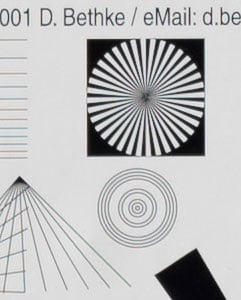 | 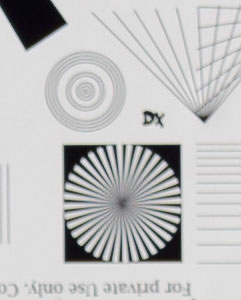 | 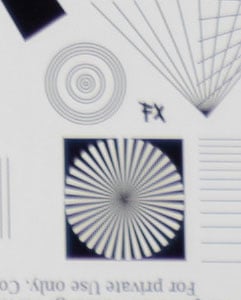 | ||
50mm, f4.0, 100 ISO | 50mm, f4.0, 100 ISO | 50mm, f4.0, 100 ISO | ||
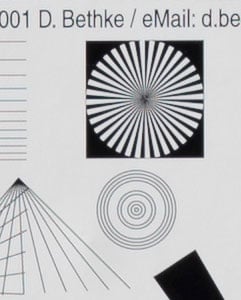 | 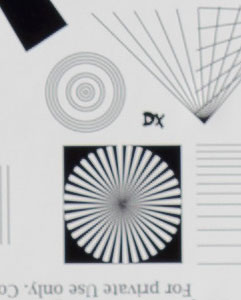 | 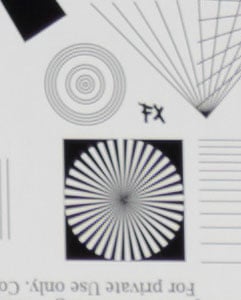 | ||
50mm, f5.6, 100 ISO | 50mm, f5.6, 100 ISO | 50mm, f5.6, 100 ISO | ||
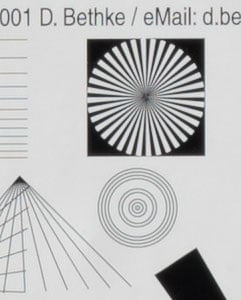 | 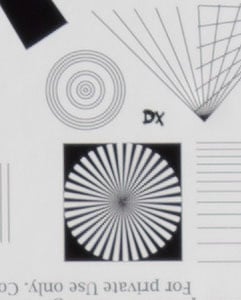 | 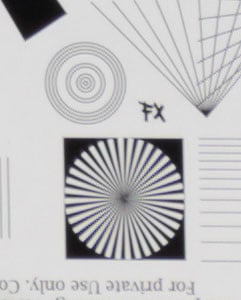 | ||
50mm, f8.0, 100 ISO | 50mm, f8.0, 100 ISO | 50mm, f8.0, 100 ISO | ||
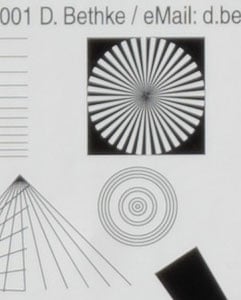 | 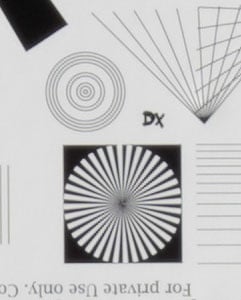 | 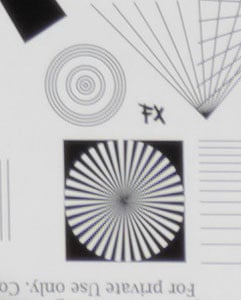 | ||
50mm, f11, 100 ISO | 50mm, f11, 100 ISO | 50mm, f11, 100 ISO |
The performance is similar to 35mm with the center less contrasty wide open and the DX-corner becoming a tad softer. But the aberrations in the FX-corner react more positively now to stopping down: f8 already produces good results with less prominent astigmatism than at 35mm. Pincushion-distortions are now clearly visible in the FX-corner.
Performance at 70mm:
Tamron 24-70mm f/2.8 VC with Nikon D800 100% crop from center | Tamron 24-70mm f/2.8 VC with Nikon D800 100% crop from DX-corner | Tamron 24-70mm f/2.8 VC with Nikon D800 100% crop from FX-corner | ||
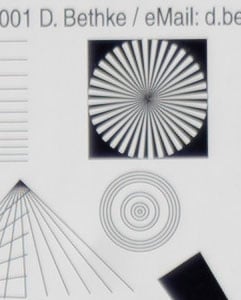 | 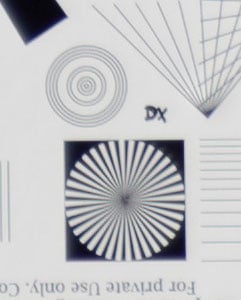 | 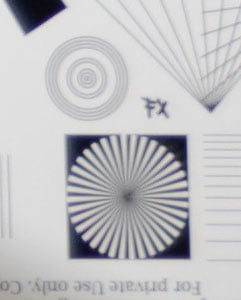 | ||
70mm, f2.8, 100 ISO | 70mm, f2.8, 100 ISO | 70mm, f2.8, 100 ISO | ||
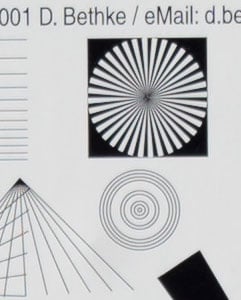 | 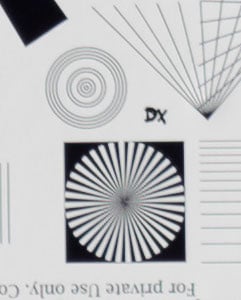 | 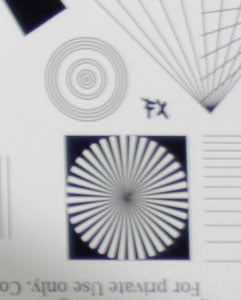 | ||
70mm, f4.0, 100 ISO | 70mm, f4.0, 100 ISO | 70mm, f4.0, 100 ISO | ||
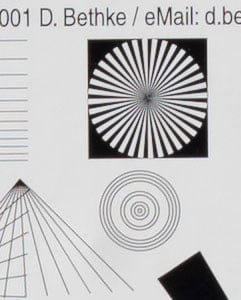 | 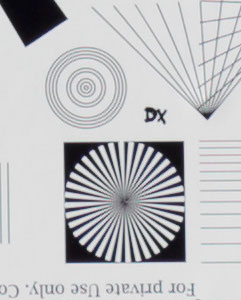 | 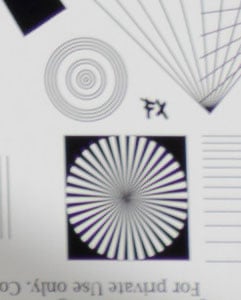 | ||
70mm, f5.6, 100 ISO | 70mm, f5.6, 100 ISO | 70mm, f5.6, 100 ISO | ||
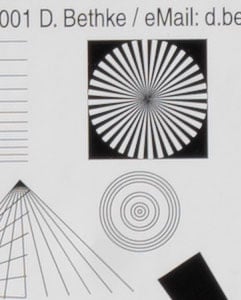 | 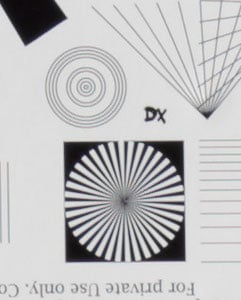 | 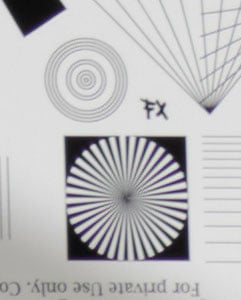 | ||
70mm, f8.0, 100 ISO | 70mm, f8.0, 100 ISO | 70mm, f8.0, 100 ISO | ||
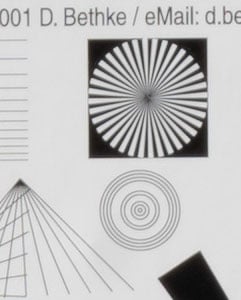 | 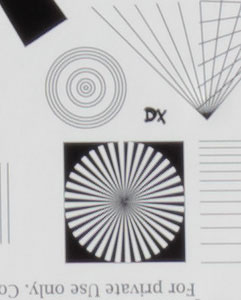 | 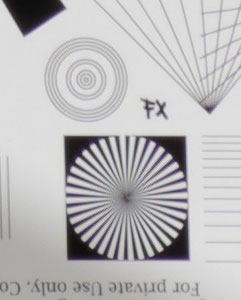 | ||
70mm, f11, 100 ISO | 70mm, f11, 100 ISO | 70mm, f11, 100 ISO |
Don’t worry about the shadow in the lower left corner of the FX-corner crop: it’s just that – a shadow on the test-target. At 70mm the performance wide open is more even across the frame than before. Stopping down to f4.0 or f5.6 gives good to very good results and stopping further down to f11 increases the image quality in the FX-corner even further although center performance is taking a hit from diffraction.
Performance at large distances
The Siemens-star test-targets are shot at a distance of 40x focal length (i.e. at 2m for 50mm f.l.). But performance of lenses also depends on the shooting distance. Therefore I do another series of test-shots of a landscape dubbed the “Unremarkables” where you can measure distances in km, not meter. In the morning, when the weather is clear and the sun is up I use this scene to show you how the lenses perform, when almost everything is at infinity. I set White Balance to a standard daylight value to make them comparable across lenses shot at the same day and also try to make exposure comparable. There’s no tinkering with vignette-control so you see it here as it is produced by the lens. Focus was acquired at the largest aperture in contrast-based AF and not changed for other apertures, VC was off.
You can click on each image to access the large original. Please respect our copyright and only use those images for personal use.
The main image shows the complete scene at maximum aperture to give you an impression of the angle of view and to judge vignetting). This is followed by one row of 100% crops at different apertures each from the middle and the right (FX-)border. Let’s start with 24mm focal length where you can clearly see some vignetting:
 | 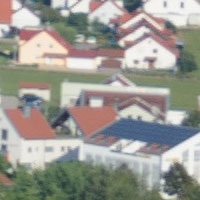 | 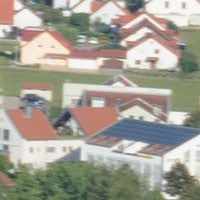 | ||
24mm, f2.8, 100 ISO, border | 24mm, f4.0, 100 ISO, border | 24mm, f8, 100 ISO, border | ||
The infinity-shot at 24mm confirms the lens’s performance from the synthetic test-target. You can also see that diffraction is already softening the center performance at f8 over f4.0. Border performance is not too bad wide open but stopping down to f8 clearly helps.
Same story at 35mm, albeit with less vignetting and a softer border performance:
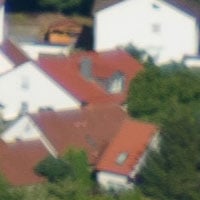 | 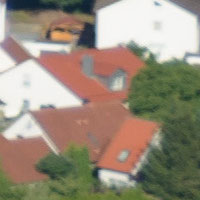 | 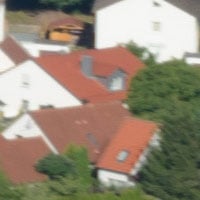 | ||
35mm, f2.8, 100 ISO, border | 35mm, f4.0, 100 ISO, border | 35mm, f8, 100 ISO, border | ||
50mm focal length seems to be a sweet spot for corner-performance. Stop down to f4 and you get pretty good results, it also benefits the overall contrast:
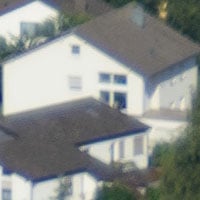 | 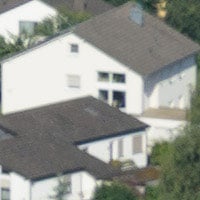 | 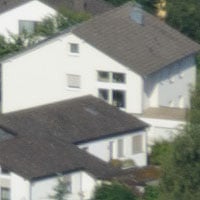 | ||
50mm, f2.8, 100 ISO, corner | 50mm, f4.0, 100 ISO, corner | 50mm, f8, 100 ISO, corner | ||
At 70mm you should stop down to f4 for improved overall contrast and f8 for better corner definition:
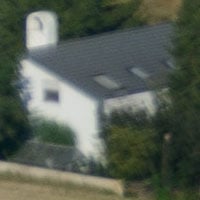 | 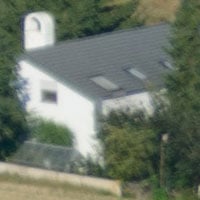 | 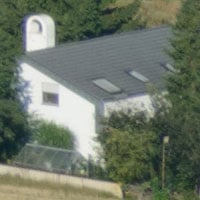 | ||
70mm, f2.8, 100 ISO, border | 70mm, f4.0, 100 ISO, border | 70mm, f8, 100 ISO, border | ||
|
Flare/ghosting
Shooting normal or wide-angle lenses always runs the risk of catching a strong light-source like the sun shining directly into the lens. This could produce strange colorful ghosts-images or reduce contrast considerably through flare and glare.
As the results depend on many factors including the aperture, focal length, and the angle the light hitting the lens the effect is not easy to reproduce faithfully. So I did a series of shots under conditions that provoke glare and ghosting. The image shows one of the shots from this series where the effects show pretty clearly.
It was easy to produce these effects but more so on the long end than on the short. Below 50mm every second shot was free from the problem and the blacks mostly stayed very black, so glare did not generally reduce the overall contrast.
As it should be easier to avoid strong light shining into the lens at 50-70mm this result is not bad.
